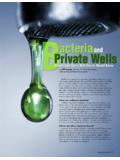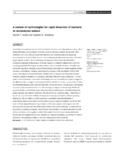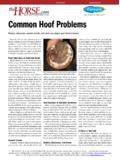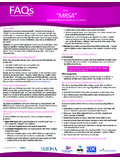Transcription of Conditions favouring coliform and HPC bacterial growth in ...
1 2003 World Health Organization (WHO). Heterotrophic Plate Counts and Drinking-water Safety. Edited by J. Bartram, J. Cotruvo, M. Exner, C. Fricker, A. Glasmacher. Published by IWA Publishing, London, UK. ISBN: 1 84339 025 6. 10 Conditions favouring coliform and HPC bacterial growth in drinking-water and on water contact surfaces LeChevallier INTRODUCTION A biofilm is a collection of organic and inorganic, living and dead material collected on a surface. It may be a complete film, or, more commonly in water systems, it is a small patch on a pipe surface. Biofilms in drinking-water pipe networks can be responsible for a wide range of water quality and operational problems.
2 Biofilms contribute to loss of distribution system disinfectant residuals, increased bacterial levels, reduction of dissolved oxygen, taste and odour changes, red or black water problems due to iron- or sulfate-reducing bacteria , microbial influenced corrosion, hydraulic roughness and reduced material life (Characklis and Marshall 1990). 178 HPC and Drinking-water Safety Figure Examples of biofilm bacteria . Microorganisms in biofilms can include bacteria (including coccoid [round], rod-shaped, filamentous and appendaged bacteria ) (Figure ), fungi and higher organisms, such as nematodes, larvae and crustaceans.
3 Recently, researchers have shown that viruses and parasites like Cryptosporidium can be trapped in biofilms (Quignon et al. 1997; Piriou et al. 2000). Although viruses and Cryptosporidium do not grow in a biofilm, they can attach to biofilms after a contamination event. Therefore, it is important to thoroughly flush the distribution system to remove these organisms following a contamination event. A primary reason why many water utilities in the USA become concerned with biofilms in drinking-water systems is due to growth of coliform bacteria within the pipe network.
4 In 2000 in the USA alone, nearly 6988 water systems affecting million people violated drinking-water microbial standards (US EPA, 2001). Of concern are the thousands of systems every year that are significant non-compliers and repeatedly detect coliform bacteria in finished drinking-water. Although some of these systems experience coliform occurrences due to cross-connections and other operational defects, a large proportion of the systems can trace their problems to regrowth of the bacteria in distribution system biofilms.
5 The large database of information on the growth of coliform bacteria can be used to better understand the growth of heterotrophic plate count (HPC) bacteria in water. This chapter reviews the factors that influence bacterial growth in chlorinated water systems. The next chapter examines Conditions specific to water systems without a disinfectant residual. This information can be used to formulate a bacterial growth control strategy. Conditions favouring growth in drinking-water 179 growth OF coliform AND HPC bacteria IN WATER Studies have examined data from a large number (over 90) of water systems to determine the factors that contribute to the occurrence of coliform and HPC bacteria in drinking-water (LeChevallier et al.)
6 1996; Volk and LeChevallier 2000). These studies have shown that the occurrence of coliform and HPC bacteria can be related to the following factors: filtration, temperature, disinfectant type and residual, assimilable organic carbon (AOC) level, corrosion control and pipe material selection. Filtration Four unfiltered surface water systems were included in one study (LeChevallier et al. 1996) and accounted for of the total number of bacterial samples collected, but (1013 of 1576) of the positive coliform samples.
7 Although the results do not suggest that treatment was inadequate ( , coliforms were not related to breakthrough of treatment barriers), the data suggested that filtration may be an important factor in preventing coliform regrowth. Following the study, one of the systems installed filtration, and distribution system coliform levels were reduced by a factor of three over the following 18-month interval. Temperature On average, the occurrence of coliform bacteria was significantly higher when water temperatures were above 15 C (Figure ).
8 Temperature is widely recognized as an important controlling factor in influencing bacterial growth . In climates where water temperatures are warm, bacterial growth may be very rapid. However, the minimum temperature at which microbial activity was observed varied from system to system. Systems that typically experienced cold water had increases in coliform occurrences when water temperatures ranged near 10 C. The strains of coliform bacteria in these systems may be better adapted to grow at lower temperatures (psychrophiles). Disinfectant residual and disinfectant level For filtered systems, there was a difference between systems that maintained a free chlorine residual and systems that used chloramines.
9 For systems that used free chlorine, of 33 196 samples contained coliform bacteria , while of 35 159 samples from chloraminated systems contained coliform bacteria (statistically different at P < ). The average density of coliform bacteria was 35 times higher in free chlorinated systems than in chloraminated 180 HPC and Drinking-water Safety systems ( colony-forming units [cfu]/100 ml for free chlorinated water, compared with cfu/100 ml for chloraminated water). Previous research (LeChevallier et al. 1990; LeChevallier 1991) has hypothesized that chloramines may be able to better penetrate into distribution system biofilms and inactivate attached bacteria .
10 Figure Relationship between monthly average water temperature and coliform occurrence. The fact that different disinfectants may interact differently with biofilms can be related to their different mechanisms of action. Free chlorine, for example, is known to react with natural organic matter to form trihalomethanes (Rook 1974). Chloramines do not form these products to the same degree. Free chlorine attacks the cytoplasmic membrane of Gram-negative bacteria to produce a cellular lesion (injury) that results in an increased sensitivity to surfactants (Zaske et al.)















